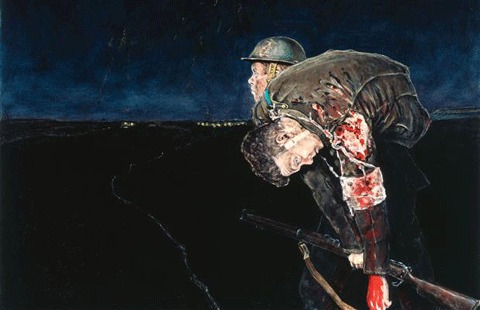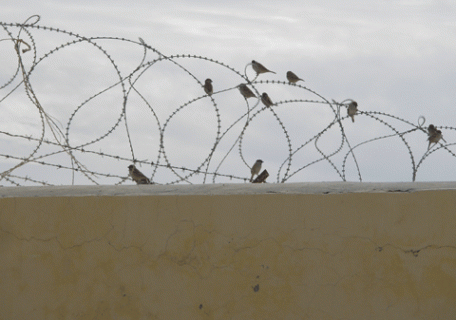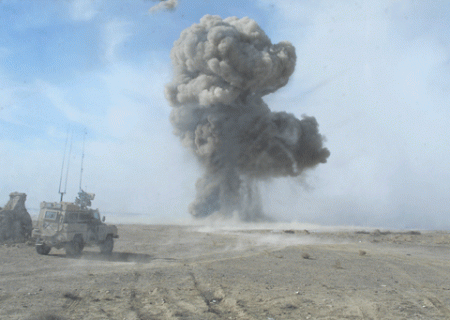Catherine Jones remembers well the advice of her professor, the late Jerry Ferguson.
“He’d say, ‘You know how to paint. Now you have to figure out what to paint,” she recalled.
The answer bonked her literally on the head. A NSCAD student in the late 1970s, she was pulling out a book from a top shelf in the library when another book slid out with it and fell on her. It was a book about war art. Although not the least bit interested at the time, she took it home and read it from cover to cover.
The daughter of Second World War vet Guy Jones, she is still surprised that she’s become a Canadian war artist. Career highlights to date include At the End of the Day, 25 life-size portraits of Second World War veterans. With a theme of forgiveness, the series includes portraits of Canadian, German and British veterans, although it’s impossible to tell who’s who. The series was exhibited in Ortona, Italy, scene of one of the bloodiest battles of the Italian campaign in 1943, and in 1998, a reconciliation event in which the Canadians were joined by their former foes for a Christmas feast. At the End of the Day was unveiled in the Senate of Canada, also went on tour to Canadian provincial legislatures in Edmonton, Regina, Toronto, Halifax and St. John’s.

In 2007, Catherine travelled to Vimy, France—a trip which inspired the painting Representative of Their Numbers, a large-scale work which represents the 19,660 Canadian service men and women from the First World War who have no known grave. The painting is a graphic portrayal of the last moments of two of those soldiers, Herbert Peterson and Thomas Lawless who were killed in 1917 but whose remains were only discovered in 2003 near Avion in the North of France. Historians and forensic scientists believe the two men—one carrying the other who was perhaps already dead—were returning from a raid when a shell exploded and buried their bodies. The haunting scene takes place in the dark of night, the two men illuminated by the blast that stole their young lives.
“With most war art, you don’t see the carnage. You tend to see the sentimental side—but that’s not war,” says Catherine.
Her work looked to the past—but as a war artist she was interested in going to the front lines. She applied through the Canadian War Artist Program to go to Afghanistan, but was told such a placement was not possible. When she heard that someone else had been chosen to go—at the unveiling of Representative of Their Numbers—she was livid. Her protestations were made in earshot of then-Brigadier-General Ian Poulter, who took it on himself to get the feisty Halifax artist to Afghanistan.
The problem was, after injuries to her back and neck, she could no longer paint—certainly not in the large scale that she liked to work in. And so the painter bought a video camera—dressing up the microphone in sunglasses and a Santa hat. At first it was disastrous. “When I brought the camera home, I burst into tears because I didn’t know how to turn the stupid thing on,” she says, “but eventually I got the hang of it.”
“I’ve always loved painting, so luscious and tactile,” she continues. “But I discovered a love of editing too—it’s like a moving painting!”
Her approval to go overseas came on December 10, 2009 and she found herself on the Khandahar Airfield on Christmas Eve in time for the ramp ceremony for Canadian soldier Lt. Andrew Nuttall, who was killed by an improvised explosive device which detonated while he was on foot patrol. Just days later, five more Canadians — Sgt. George Miok, Cpl. Zachery McCormack, Sgt. Kirk Taylor, Pte. Garrett Chidley and Calgary Herald journalist Michelle Lang—were killed in a bomb blast on one of Khandahar’s perilous roads.
Called 15: 13, her documentary is an unvarnished look at the Canadians in Afghanistan, particularly the soldiers of the Canadian Forces’ National Support Element—the truckers, mechanics, cooks and clerks, or, as Catherine says “the beans, boots and bullets people.” The film has no narration and is a linear retelling of the filmmaker’s month in Afghanistan during a particularly tumultuous time.
“It is,” says Catherine, “absolutely realistic,” lurching from somber and downcast at one moment to celebratory and humorous the next. The title 15: 13 refers to the Bible passage from the Book of John— “Greater love hath no man than this. That a man lay down his life for his friends.”
As a Canadian war artist, Catherine is hoping to serve in another way; with proceeds from 15:13, she would like to open an art school for soldiers with post-traumatic stress disorder.
“There is not one emotion known to mankind that a paintbrush cannot express,” says Catherine, who is still recovering from the injuries that keep her from her easel. “I think it would be extraordinary. Instead of just honoring them, this would be helping them.”
|
|
|
[/mk_table]



